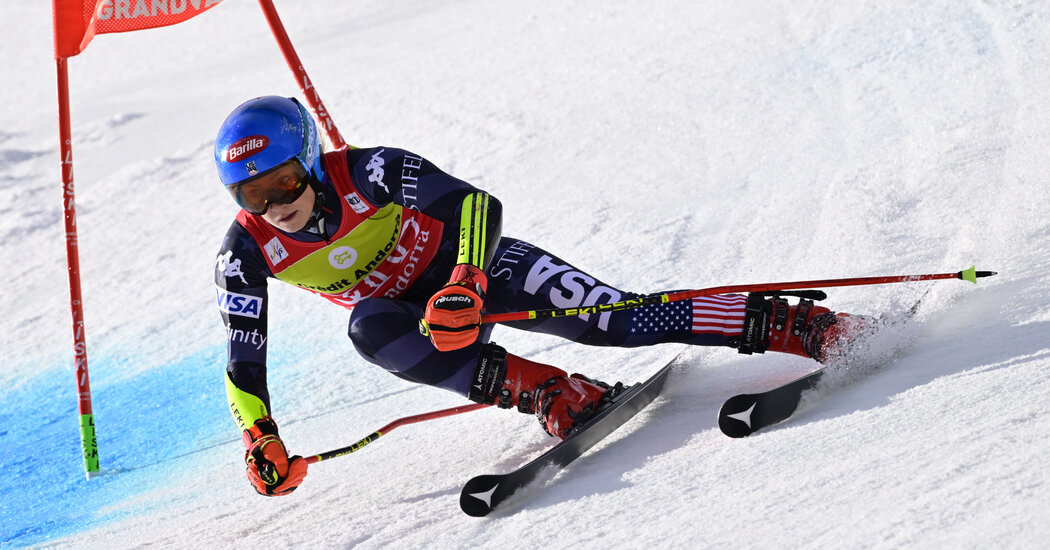
No one in American competitive skiing planned it this way.
No one at the headquarters of the U.S. Ski and Snowboard Association in Park City, Utah, a dozen years ago scratched out a plan to have the two greatest Americans ever to click into Alpine and cross-country skis peak simultaneously.
It only seems like it, with Mikaela Shiffrin and Jessie Diggins showing off their once-in-a-generation talents and thrusting what are largely considered niche sports in the U.S. into the mainstream.
Shiffrin, 28, won an absurd 14 World Cup races this season, putting her at a record 88 wins overall, two better than the Swedish star Ingemar Stenmark’s 86. She won the World Cup overall, slalom and giant slalom titles, plus a gold medal and two silvers at the biennial Alpine world championships, the biggest event in skiing outside of the Olympics.
“Exciting, nerve-racking and very emotional,” is how Shiffrin summed up her season following her final victory in the giant slalom in Andorra last weekend.
Diggins, 31, still has a couple of races left this weekend, which will be her last chances to win her second overall title as the best all-around skier and the best distance skier — she is in second place in both races. At the world championships, she won two World Cup races, giving her 14 in her career, a record for an American, and became the first American to win an individual gold medal at the event. She also won a bronze medal with Julia Kern in the team sprint.
She is the main reason the U.S. will likely finish third in cross-country’s Nations Cup, which ranks the most successful teams across all competitions (men and women), behind only Norway and Sweden, where children practically emerge from the womb wearing cross-country skis. That would be among the best performances ever for the U.S. in the event — and ahead of Germany, Finland, Italy and France, which are traditionally strong Nordic sports countries. It is a result that is especially pleasing for Diggins.
“The team ones mean so much more to me,” Diggins said of her successes after the world championships in Slovenia.
The success of Shiffrin and Diggins is a microcosm of the growing dynamic for America in Olympic sports, with women increasingly leading the way, largely because of increased funding for women’s sports during the past 50 years and the culture that has been built around them in the U.S. The U.S. won 25 medals at the 2022 Winter Olympics in Beijing, including 17 in women’s or mixed events. At the last Summer Olympics in 2021 in Tokyo, women’s, mixed and open events (which can, but don’t have to, include men or women, such as equestrian) accounted for 72 of 113 medals.
In addition to continuing the individual prowess, the trick now for Shiffrin, Diggins and America’s skiing aficionados will be to figure out how to snowball their success into something more lasting — and how to bring some of the men along for the ride.
Paula Moltzan, Shiffrin’s longtime teammate who is just nine months older than her, and Travis Ganong, another veteran, were the only other American Alpine skiers to reach a World Cup podium this year, and they each did so only once. The Americans won the team gold medal at the world championships, though the top athletes from many countries do not participate in that event.
“We are on a good track, but we definitely have a lot of work to do,” said Patrick Riml, the Alpine director for the U.S. ski team, which, Shiffrin aside, is rebuilding after the retirement of a golden generation of athletes who were arguably the best in the world a decade ago.
The hope is that Americans who have had success internationally as juniors, such as Sam Morse and Jett Seymour, who are now in their mid-20s, or those who have shown hints of early promise in the World Cup, such as Nina O’Brien and Ava Sunshine, who is just 20 years old, will mature into top competitors on the World Cup circuit as they reach their athletic peaks.
“It takes a long time to develop athletes in our sport,” said Chip Knight, the U.S. team’s Alpine development director. “The guys generally take a little longer.”
Riml’s counterpart on the Nordic side, Matt Whitcomb, the head coach for the U.S. cross-country team, said his group had learned to embrace being the World Cup circuit’s scrappy fighters, who make up for shortcomings in support staff and funding with effort and teamwork. The team has two of the top four and three of the top 12 women in the overall standings (Diggins, Kern and Rosie Brennan). Ben Ogden, a 23-year-old who may yet turn out to be the male Diggins, is in eighth in the men’s overall standings heading into the final weekend.
“There is something motivating about operating as an underdog,” Whitcomb said.
Her fellow skiers have all worshiped Diggins for years, and they celebrate her successes as their own.
“When Jessie wins, we all win,” is Ogden’s famous refrain.
Ogden, his mustache and his fearless approach are quickly becoming favorites of the sport’s devotees, who scream for him during races through the woods and cities of Europe. His coaches, fearful of stifling his preternatural speed and his still-developing aerobic capacity, have essentially told him to eschew racing tactics, instead letting him “develop in the wild,” as Whitcomb put it.
“It’s too soon to start him in with a conservative approach,” said Whitcomb, who compared Ogden to Steve Prefontaine, the mustachioed middle-distance runner of the 1970s who was famous for his guts-first running style. “Just like Prefontaine, Ben wakes up and says, ‘Today is a good day to die.’”
Money is the simplest explanation for why both teams boil down to a unicorn-style star and a mostly younger cohort of athletes with promise who are still developing.
For roughly a dozen years, beginning in the mid-2000s, the U.S. Alpine team invested mainly in its top skiers, forcing developing skiers to cover a significant portion of their expenses. Shiffrin, the child of ski racers whose at-home tutelage and talent made her a wealthy world champion at 17 and an Olympic champion at 18, could manage on her own, but nearly everyone else her age could not. Might there have been other rare, later-blooming talents who turned away from the sport too soon because of its expense? U.S. skiing will never know.
Similarly, the cross-country team for years survived on a bare-bones budget. Only after the success of Kikkan Randall, who in 2012 became the first American woman to win a World Cup discipline title, and Diggins, who teamed with Randall for a world championship when she was just 21, did the national federation begin to invest more heavily in the sport. Ogden, Kern, who is 25, and Sophia Laukli, who is 22 and achieved her first career podium at the Tour de Ski in January, are among the fruits of that investment.
Barring injuries, Shiffrin and Diggins should continue doing their thing for the next two and a half seasons and enter the 2026 Winter Olympics in Cortina, Italy, as favorites for multiple medals. The bigger task is to try to ensure they are not alone.

